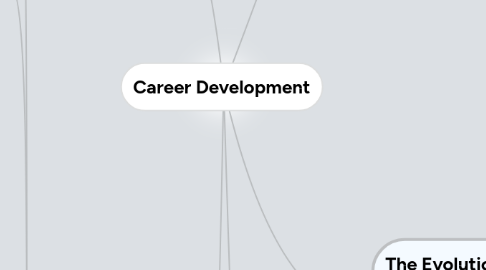
1. Career Planning & Development
1.1. CAREER PLANNING & DEVELOPMENT - The deliberate process through which a person becomes aware of persona career-related attributes & the lifelong series of activities that contribute to his or her career fulfilment
2. Management Development
2.1. MANAGEMENT DEVELOPMENT - Any attempt to improve current or future management performance by imparting knowledge, changing attitudes, or increasing skills
2.1.1. Importance
2.1.1.1. Baby boomers entering retirement
2.1.1.2. Increased demand for next generation to assume senior management
2.2. SUCCESSION PLANNING - A process though which senior-level & critical strategic job openings are planned for & eventually filled
2.2.1. Begins w/ three steps
2.2.1.1. 1. Establishing strategic direction & jobs that are critical to achieving it
2.2.1.2. 2. Identifying core skills & competencies needed in jobs that are critical to achieve strategy
2.2.1.3. 3. Identifying people inside the organization who have, or can acquire, those skills & providing them w/ developmental opportunities (being prepared to recruit externally as well)
2.3. Management development
2.3.1. Attracts talent
2.3.2. Helps organization achieve employer-of-choice status
2.3.3. Techniques
2.3.3.1. DEVELOPMENTAL JOB ROTATION - A management training technique that involves moving a trainee from department to department to broaden his or her experience & identify strong & weak points
2.3.3.2. Coaching/Understudy approach
2.3.3.3. ACTION LEARNING - A training technique by which management trainees are allowed to work full time, analyzing & solving problems in other departments
2.3.3.4. Outside seminars
2.3.3.5. College/university-related programs
2.3.3.6. IN-HOUSE DEVELOPMENT CENTERS - A company-based method for exposing prospective managers to realistic exercises to develop improved management skills
2.3.4. Process
2.3.4.1. 1. Assessing HR needs to achieve strategic objectives
2.3.4.2. 2. Creating a talent pool
2.3.4.3. 3. Developing managers
2.4. Behaviour modelling
2.4.1. BEHAVIOUR MODELLING - A training technique in which trainees are first shown good management techniques, then asked to play roles in a simulated situation & finally given feedback regarding their performance
2.4.1.1. Basic behaviour-modelling procedure
2.4.1.1.1. 1. Modelling
2.4.1.1.2. 2. Role-playing
2.4.1.1.3. 3. Social reinforcement
2.4.1.1.4. 4. Transfer of training
2.4.1.2. CASE STUDY METHOD - A development method in which a trainee is presented w/ a written description of an organizational problem to diagnose & solve
2.4.1.3. ROLE-PLAYING - A training technique in which trainees act the parts of people in a realistic management sitaution
2.4.1.4. MANAGEMENT GAME - A computerized development technique in which teams of managers compete w/ one anotter by making decisions regarding realistic simulated companies
2.4.2. MENTORING - The use of an experienced individual (the mentor) to teach & train someone (the protoge) w/ less knowledge in a given area
3. Leadership Development
3.1. Canada facing shortage of leadership talent
3.2. Banff Centre leadership program
3.2.1. Requirements for successful leadership: knowledge, competency, character
3.2.2. Six categories of leadership competencies
3.2.2.1. 1. Self-mastery
3.2.2.2. 2. Futuring/vision
3.2.2.3. 3. Sense-making/thinking
3.2.2.4. 4. Decision of intelligent action
3.2.2.5. 5. Aligning people to action/deading
3.2.2.6. 6. Adaptive learning
4. The Evolution of Career Development
4.1. The evolution of career development
4.1.1. OCCUPATIONAL ORIENTATION - The theory, that there are six basic personal orientations that determine the sorts of careers to which people are drawn
4.1.2. Six basic personality types or orientations
4.1.2.1. 1. Realistic orientation
4.1.2.2. 2. Investigate orientation
4.1.2.3. 3. Social orientation
4.1.2.4. 4. Conventional orientation
4.1.2.5. 5. Enterprising orientation
4.1.2.6. 6. Artistic orientation
4.2. New approaches to career development
4.2.1. More frequent job transitions
4.2.2. More dynamic & holistic approach to career development
4.2.3. Primary stakeholder is the person
4.2.4. Linear career paths lose definition
4.2.5. Focus on lifelong learning & flexibility
4.2.6. Identify skills & aptitudes
4.2.6.1. General aptitude test battery (GATB)
4.2.7. Identify CAREER ANCHORS - A concern or value that a person will not give up if a choice has to be made
4.2.7.1. Six career anchors
4.2.7.1.1. 1. Technical/functional
4.2.7.1.2. 2. Managerial competence
4.2.7.1.3. 3. Creativity
4.2.7.1.4. 4. Autonomy
4.2.7.1.5. 5. Security
4.2.7.1.6. 6. Service/dedication
4.2.7.1.7. 7. Pure challenge
4.2.7.1.8. 8. Lifestyle
4.2.8. Focus on life trajectories
4.2.8.1. Designing career & life simultaneously
4.2.8.2. Five required shifts in thinking
4.2.8.2.1. 1. From traits & states to context
4.2.8.2.2. 2. From prescriptive to process
4.2.8.2.3. 3. From linear to non-linear
4.2.8.2.4. 4. From scientific facts to narrative evaluations
4.2.8.2.5. 5. From describing to modelling
4.2.9. Become a learning organization
4.2.9.1. LEARNING ORGANIZATION - An organization skilled at creating, acquiring & transferring knowledge & at modifying its behaviour to reflect new knowledge & insights
4.3. Roles in career development
4.3.1. The individual
4.3.1.1. Individual must accept responsibility for career
4.3.1.2. Requires
4.3.1.2.1. Self-motivation
4.3.1.2.2. Independent learning
4.3.1.2.3. Effective time & money management
4.3.1.2.4. Self-promotion
4.3.1.3. Networking is the foundation of effective career mamagement
4.3.2. The manager
4.3.2.1. Should provide timely & objective performance feedback
4.3.2.2. Offer developmental assignments & support
4.3.2.3. Participate in career development discussions
4.3.2.4. Act as a coach, appraiser, advisor, referral agent
4.3.3. The employer
4.3.3.1. Provide career-oriented training & development opportunities
4.3.3.2. Offer career information & programs
4.3.3.3. Offer a variety of career options
5. Managing Transfers & Promotions
5.1. Managing transfers
5.1.1. Employees seek
5.1.1.1. Greater possibility of advancement
5.1.1.2. Personal enrichment
5.1.1.3. More interesting job
5.1.1.4. Greater convenience
5.1.2. Employers want to
5.1.2.1. Fill vacant positions
5.1.2.2. Find better fit for an employee
5.1.3. Trends
5.1.3.1. Routine transfers (for job exposures, to fill vacancies) are on the decline due to cost & disruption to family life
5.1.3.2. 2/3 of transfers are refused by employees due to family/spousal concerns
5.1.3.3. Employers are offering spousal support
5.2. Making promotion decisions
5.2.1. Three decisions
5.2.1.1. 1. Is seniority or competence the rule?
5.2.1.2. 2. How is competence measured?
5.2.1.3. 3. Is the process formal or informal?
